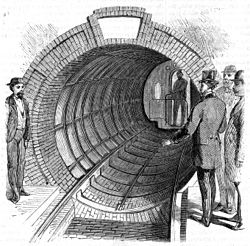Capt Worley PE
Run silent, run deep


In a blog post today, Elon Musk revealed plans for an alpha version of his much-anticipated Hyperloop, an innovative transportation system that would move passengers from Los Angeles to San Francisco in less than 30 minutes. According to the plans (PDF), the Hyperloop would transport passengers in aluminum pods traveling up to 800mph, mostly following the route of California's I-5. The estimated cost would be $6 billion for passenger-only model, or $10 billion for a larger model capable of transporting cars. On a following conference call, Musk said he expected a prototype unit might take only three or four years to complete given the right project leader, including a couple years to acclimate themselves to the project. "If it was my top priority, I could probably get it done in one or two years."
http://www.theverge.com/2013/8/12/4614940/elon-musk-reveals-plans-for-high-speed-hyperloop
Ahem.....

http://en.wikipedia.org/wiki/Beach_Pneumatic_TransitIn 1869, Alfred Ely Beach and his Beach Pneumatic Transit Company of New York began constructing a pneumatic subway line beneath Broadway. (Beach had earlier demonstrated the basic system at the American Institute Exhibition in 1867.) Funneled through a company he set up,
Beach put up $350,000 of his own money to bankroll the project.[1] Built in only 58 days,[2] its single tunnel, 312 feet (95 m) long, 8 feet (2.4 m) in diameter, was completed in 1870 and ran under Broadway from Warren Street to Murray Street.[3]
With no initial political support for his project, he started the project claiming he was building postal tubes. The initial permit was to install a pair of smaller postal tubes below Broadway but was later amended to allow the excavation of a single large tunnel wherein the smaller tubes could reside.[4]The exact location of the tubes was determined during construction by compass and survey as well as verified by driving jointed rods of iron up through the roof of the tunnel to the pavement.[5] The line was built as a demonstration of a pneumatic transit system, open to the public with fares donated to charity. Proceeds of the 25 cent admission went to the Union Home and School for Soldiers' and Sailors' Orphans.[6]
It remained little more than a curiosity, running only a single car on its one-block-long track to a dead-end at its terminus. (Passengers would simply ride out and back, to see what the proposed subway might be like.) During its first two weeks of operation, the Beach Pneumatic Transit sold over 11,000 rides with 400,000 rides provided during its first year of operation.[7][8]
Also: http://www.oobject.com/category/pneumatic-trains/



